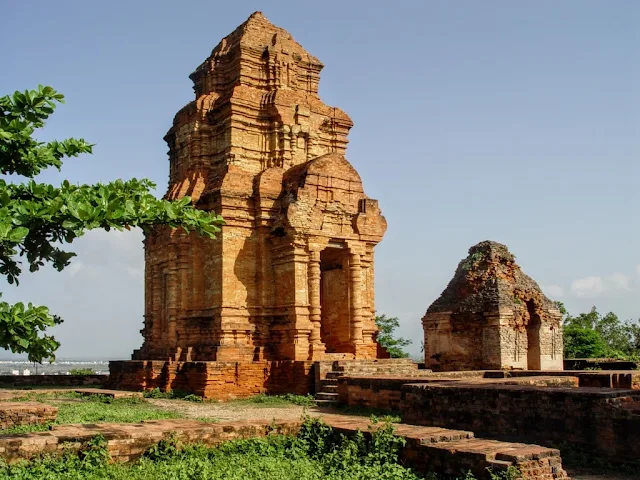
|
| Eighth century Cham temple dedicated to Lord Shiva |
 |
| Indochina in 1100 |
 |
| Remains of Cham temple in Phan Rang |
Chapter 1, 2, 3, 4, 5, 6, 7, 8, 9, 10, 11, 12, 13, 14, 15, 16, 17, 18, 19, 20, 21, 22, 23, 24, 25, 26, 27, 28, 29, 30 📗
Original translation of Sejarah Melayu by Dr John Leyden
Chapter 19 of 30
THERE was a betel-nut tree near the palace of the Champa Raja, which blossomed and exhibited a large receptacle for fruit, but the fruit never seemed to ripen. The raja then ordered one of his servants to climb up and see what was in the pod. He ascended accordingly, and brought down the pod, which the raja caused to be opened, and saw in it a male child extremely handsome and beautiful. Of this pod's envelope was formed the gong, named jubang; while a sword was formed of its sharp ridge.
The Champa Raja was greatly pleased at the circumstance, and named the child Raja Pogalang, and ordered him to be suckled by all the wives of the raja-rajas, and para-mantris; but the child would not suck. The Champa Raja had a cow whose hair was of the five colours, and which had lately calved, and they suckled the child with the milk of this cow. This is the reason that Champa never eats the cow, nor kills it. Raja Pogalang grew up, and the raja of Champa gave him his daughter Pobea to wife.
After a short time, the Champa Raja died, and Pogalang succeeded to the throne. After he had reigned for a considerable time, he founded a great city, which included seven hills within its bounds. The extent of the fort was a day's sail in each of its four sides, with sails full distended with the breeze. The name of this city was Bal, which, in a certain Cheritra, is named Metakat, the city of Raja Subal, the son of Raja Kadail. After some time Pobea bore to Pogalang a son named Potri. When he was grown up Pogalang died, and Potri succeeded to the throne, and married the daughter of the raja of Cochi, named Bea Suri, who bore him a son named Pogama; and Potri died.
After this Pogama prepared to visit Majapahit. He went accordingly thither, and information was brought that the raja of Champa had come to visit the paduca bitara. The bitara ordered his great men to go out and meet him, and they accordingly received him with the greatest respect, and the bitara gave him in marriage his daughter, named Radin Galu Ajong. After some time she became pregnant, and Pogama asked permission to return to his own country; but the bitara, while he assented to his return, would not suffer him to carry his daughter with him. Pogama said, "I will not stay long away, but I will quickly return to present myself before Your Majesty."
Then Pogama went and asked of his spouse, Radin Galu, permission to take his departure. Radin Galu said, "if my child should be a boy, what shall be his name?" Pogama said, "If it is a boy, name him Raja Jignak; and when he grows up, send him to me at Champa." Raja Jignak grew up, and he asked his mother "who is my father?" She said, " Pogama, the raja of Champa; he has returned to Champa." She then told him the whole account of his birth. When he heard this, he prepared a prahu to go to Champa.
When he arrived at Champa, he went to meet his father, who received him gladly, and gave him the government of Bal. Pogama died, and Raja Jignak succeeded him. He married the Princess Putri Pochi Banchi, and begot a son named Pogopoh. When Pogopoh grew up Raja Jignak died. Pogopoh begot a daughter, who was asked in marriage by the raja of Cochi, but Pogopoh would not give her in marriage to him. The raja of Cochi then attacked him, and Cochi fought with Champa a terrible battle.
How long was it before victory declared for either! On a day the raja of Cochi offered the bandahara of Champa, an immense sum to commit treason, to which the bandahara of Champa agreed, and received it; and towards evening he opened the gate of the fortress, and all the champions of Cochi entered into the fort of Bal, and run amok on the people of Champa. The half of them continued the fight, and the half of them guarded the women and children. The fortress of Bal was taken, and Pogopoh was slain, and all the young nobles of Champa fled nobody knew where.
There were two sons of the raja of Champa, the one named Indra Brama, and the other Poling, both of whom fled with their wives and dependents. Poling passed to Achi, of which he became the original raja. The other, Shah Indra Brama, arrived at Malaca, where he was gladly received by Sultan Mansur, who had him converted to Islam, and made him a mantri; but he was an original Champa man.


_during_the_reign_of_King_Che_Bunga.png)


No comments:
Post a Comment
All comments submitted with genuine identities are published